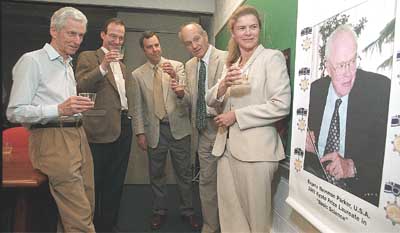Parker awarded prestigious Kyoto Prize for elucidating solar wind, other phenomena
By Steve KoppesNews Office
 Eugene Parker, the S. Chandrasekhar Distinguished Service Professor Emeritus in Physics, Astronomy & Astrophysics and the College, was recently honored by the Inamori Foundation, which announced it would present Parker with the 2003 Kyoto Prize for Lifetime Achievements for Basic Science. |
Parker, the S. Chandrasekhar Distinguished Service Professor Emeritus in Physics, Astronomy & Astrophysics and the College, has tested the scientific waters with his sometimes controversial theories of cosmical magnetohydrodynamics, but rarely did he need to retreat.
On Friday, June 20, the Inamori Foundation announced it would reward Parker for his theories with the 2003 Kyoto Prize for Lifetime Achievements for Basic Science. The $400,000 Kyoto Prizes recognize significant lifetime contributions to the scientific, cultural and spiritual development of mankind.
Parker will be cited for establishing a new perspective on astrophysics by elucidating the solar wind and other cosmic phenomena. When asked how he felt about it, Parker said, “I’m still trying to get used to the idea. It’s a tremendous honor.”
Parker said his career has been full of scientific surprises. “It’s been great fun. You let nature, in the form of astronomy, tell you what’s happening, and then you sit there and try to figure out why, and sometimes you can and sometimes you still don’t know enough to figure out why.”
Also named as Kyoto Prize laureates this year are Harvard University Professor George Whitesides and Bunraku puppet master Tamao Yoshida of Osaka, Japan.
Whitesides, a chemist, will receive the Kyoto Prize for Advanced Technology for pioneering a technique of organic molecular self-assembly and its applications in the field of nanomaterials science. Yoshida, a master of Bunraku puppetry, a classical Japanese performance art, will receive the Kyoto Prize for Arts and Philosophy. The prize will go to Yoshida for his significant contributions to Bunraku’s current status as the world’s most highly refined form of puppet theater.
“Today, we are rushing ahead with incredible scientific and technological achievements, while understanding of our emotional and psychological development lags deplorably,” said Kazuo Inamori, founder and president of the Inamori Foundation. “It is my hope that the Kyoto Prizes will encourage balanced development of both our scientific and our spiritual sides, and hence provide new impetus toward the structuring of new philosophical paradigms.”
The 2003 Kyoto Prize for Basic Science was chosen from the fields of earth and planetary sciences and astronomy and astrophysics. In 1958, Parker made a theoretical prediction of a supersonic flow of plasma (ionized gas) from the expanding solar corona, which he called the “solar wind.”
“The opposition to the solar wind was vociferous,” Parker said. But several years later, the solar wind’s existence was proven through direct satellite observation, which made it possible to expound the causes of magnetic storms, auroras and other solar-terrestrial phenomena. “All of a sudden, everybody always knew there had been a solar wind,” he said.
 In his absence, Eugene Parker’s colleagues gathered for a reception to toast him, after hearing that the Inamori Foundation had named Parker a recipient of one of its Kyoto Prizes. Although Parker was unable to attend the gathering, his colleagues celebrated his pioneering research in solar astronomy as well as the prize he won for that work. Joining in the celebration were (left to right) Roger Hildebrand, the Samuel K. Alison Distinguished Service Professor in Physics and the College; Frank Merritt, Professor in Physics and the College; Robert Fefferman, Dean of the Physical Sciences Division and the Max Mason Distinguished Service Professor in Mathematics and the College; James Cronin, University Professor Emeritus in Physics and the College; and Angela Olinto, Chair and Associate Professor in Astronomy & Astrophysics. |
Having shown that the space between the sun and the Earth is filled with this supersonic gas flow—and not a vacuum, as had been believed—Parker’s theory triggered drastic changes in the perception of space.
In addition, Parker has studied cosmical magnetohydrodynamics, the large-scale dynamics of gas and magnetic fields in space over scales just larger than a mile. He applied cosmical magnetohydrodynamics to the development of the Dynamo Theory and what has come to be known as the Parker Instability. These have helped explain a broad range of phenomena involving fixed stars, the interstellar medium and the galaxy, creating a new perception of space physics. For his groundbreaking work, Parker received the National Medal of Science in 1989.
His book, Cosmical Magnetic Fields—Their Origin and Activity (1979), comprises the vast body of his many years of research findings. Regarded as the bible of cosmical magnetohydrodynamics, it is quoted authoritatively to this day in scientific papers within that discipline. Parker also is the author of more than 300 scientific papers.
Kazuo Inamori, founder and chairman emeritus of Kyocera Corporation, established the Inamori Foundation in 1984. The Kyoto Prizes were founded the following year.
![[Chronicle]](/images/sidebar_header_oct06.gif)